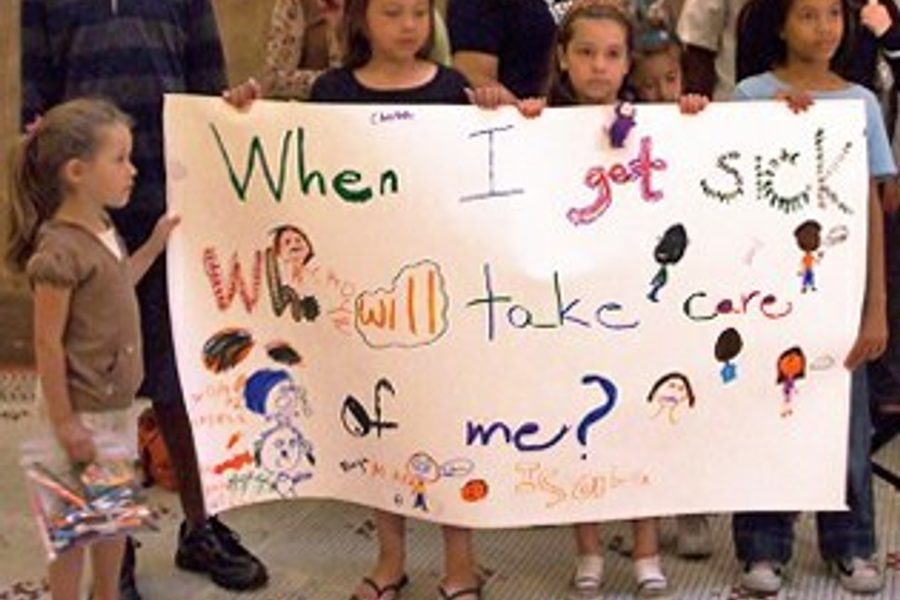
California seems to always be teetering on the brink of financial collapse or political implosion. But this week, the state got news that something about their government actually works. A simple measure to support workers, paid family leave, has not only proved to be a boon to working families but also has had no significant negative impact on jobs. The only problem, according to a new study published by the Center for Economic and Policy Research and other organizations, is that paid leave isn’t used by more people.
Since July 2004, the law has enabled most working Californians to take time off to care for a new child or a sick relative for up to six weeks while still retaining “55 percent of their usual weekly earnings, up to a maximum benefit of $987 per week in 2011,” according to the study, based on the principle that time for “bonding” and “care” are integral to the well-being of working households. Covering workers across the public and private sectors, the law has a wider scope and far more generous benefits than federal Family and Medical Leave Act, which guarantees only non-paid leave for firms above a certain size.
California’s program, along with similar initiatives passed in Washington and New Jersey are rare, as other states and localities have failed to push through legislation in the face of the powerful business lobby. The standard opposition line is that paid leave costs employers too much and “kills jobs.”
California’s example counters the alarmist arguments, according to economist Eileen Appelbaum and sociologist Ruth Milkman. Their survey revealed that benefits of California’s program have far outweighed the costs for both employers and workers.
One primary finding is that people in “low quality” jobs (with lower pay and benefits) tend to have more to gain:
Use of [Paid Family Leave (PFL)] greatly increased the level of wage replacement during family leaves for respondents in low-quality jobs: 84 percent of those in low-quality jobs who used PFL received at least half of their usual pay while on leave, compared with 31 percent of those in low-quality jobs who did not use it.
Use of PFL positively affected respondents’ ability to care for a new baby or adopted child. Among workers in low-quality jobs who used PFL for bonding leaves, 91 percent reported a positive effect on their ability to care for the new child, compared with 71 percent of those who did not use PFL….
PFL doubled the median duration of breastfeeding for all new mothers who used it, from five to eleven weeks for mothers in high-quality jobs and from five to nine weeks for those in low-quality jobs.
Use of paid leave by workers in low-quality jobs was associated with a higher rate of workers staying with employers, compared with those who did not use the program.
Researchers noted that “The proportion of bonding claims filed by men has gone up steadily and substantially,” suggesting that the program has helped many fathers catch up on their parenting credentials. Most reported that “they were ‘very satisfied’ or ‘somewhat satisfied’ with the amount of money they received.”
But despite these outcomes, many have been left out of paid leave, often because they’re not aware of it. Low-wage workers and immigrants have relatively low awareness of the policy. Just a third of the Latino respondents knew about paid family leave, compared with over half of whites. Women, not surprisingly, were more aware of the policy than men. But overall, the researchers concluded, “awareness of PFL is least extensive among the demographic groups that need it the most.”
There were also workers who opted not to take paid leave for various reasons that show limitations of the program. For some, the compensation didn’t seem high enough. Others, sadly, feared that taking advantage of the program would upset their employers, get them fired, or “hurt their chances for advancement.”
The research suggests that by helping with retention of workers, the program may especially benefit “smaller employers that may be unable to afford high levels of wage replacement for workers who need to take a family leave, but wish to retain those workers.” (Of course, keeping people in jobs of lower quality should not be a goal in and of itself, but any supports that improve conditions for those workers helps low-income and disadvantaged communities that can’t immediately access better opportunities.)
The central question posed by the study is how the program can be scaled up to reach the workers who face the most hardships as they balance caregiving with work?
Nationally, leave benefits, even the basic provision of paid sick days for workers, have been orphaned by lawmakers; the Healthy Families Act, which would provide paid medical leave on the federal level, has languished in Congress. The Institute for Women’s Policy Research reported recently that 44 million private sector workers nationwide had no access to paid sick leave in 2010, essentially forcing workers to choose between working while sick or losing wages.
The experience of California with paid family leave shows that something as simple as an extra day with a child or ill loved one can help families stay healthy, maintain economic stability, and even parent children more equitably. It’s the kind of common sense that our political arena could use a bit more of.
Michelle Chen is a contributing writer at In These Times and The Nation, a contributing editor at Dissent and a co-producer of the “Belabored” podcast. She studies history at the CUNY Graduate Center. She tweets at @meeshellchen.








